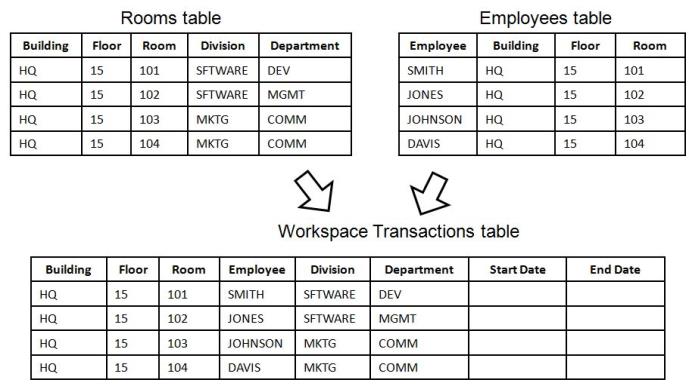Space / Space Inventory (Transactional)
Space / Occupancy / Space Manager (Transactional)
The Rooms, Employees, and Workspace Transactions Tables
The Rooms table stores physical and permanent attributes about a room, such as building and floor, room standard, cost, employee capacity, drawing name, and area. It also stores any “roll-up” information from its associated Workspace Transaction (rmpct) records, such as occupancy count, primary division, primary department, primary category, and primary type.
The Workspace Transactions table (the rmpct table) stores room attributes that are subject to change and that may include more than one value per room, such as division, department, proration, category, type, and employee. It also stores a history of attribute changes by applying date ranges to those attributes. In this way, the Workspace Transactions table is linked to requests for attribute changes, such as employee moves and department claims.
The Employees table holds location information. However, since the Workspace Transactions table also holds occupancy information, the Employees table holds only each employee’s main – or primary – location.

The division and department assignments in the Workspace Transactions table can come from either the Employees table or the Rooms table. This is controlled by the InferRoomDepartmentparameter that you set with the Configure Application Parameters task. In the above example, the workspace transaction records inherit the division and department assignment from the room. If employee Smith, in room HQ-15-101 is in a department other than SFTWARE-DEV, this fact is not carried over to the Workspace Transactions table.
The distinction between a room’s “primary” attributes and the attributes stored in the Workspace Transactions table is not important in every deployment. Indeed, the Workspace Transactions attributes for a given room might always be the “primary” attributes. However, there are cases where the distinction is important.
For example, an organization may assign rooms to divisions and departments once per year. The Division/Department, therefore, may always “own” the room and be charged for their assigned rooms whenever the room is either vacant or occupied by an employee of that division/department. However, if an employee of another division/department moves to that room temporarily, then his or her division/department is charged for the time period that the employee occupies the room. When the employee vacates again, then the chargeback goes back to the “primary” division/department. In this case, the system needs to keep a record of the “primary” division/department (in the rm table), and the “temporary” division/department assignment (in the rmpct table).
Note: If you need to delete a room and there are requested Workspace Transaction records, you should delete the Workspace Transaction records before the Room record. A Room record should not be deleted if there are pending requests that involve that record.